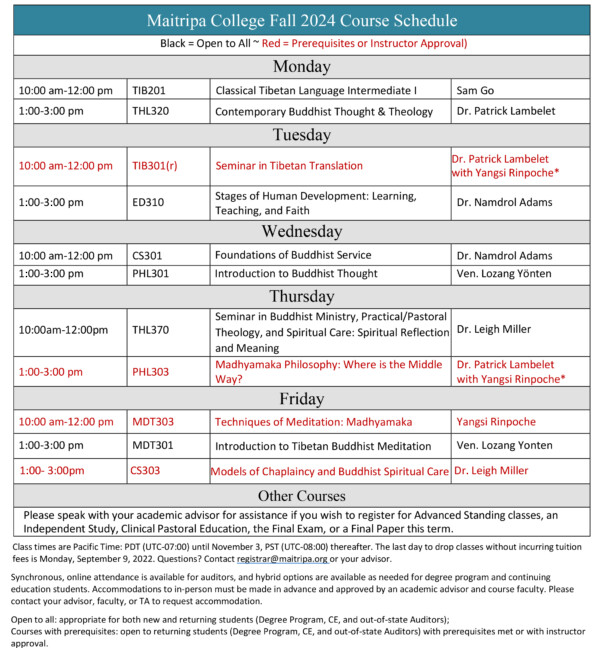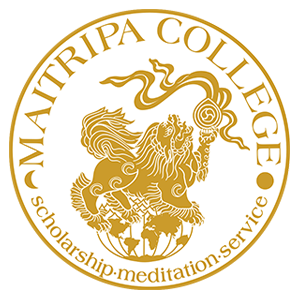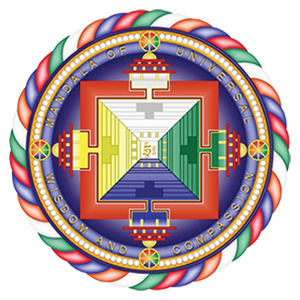~Registration for Fall 2024 is now open (use links on the right)~
Course descriptions are at the bottom of this page and faculty bios are here
Classes begin August 26 and end December 13; last day to enroll/add/drop a class is September 13.

CS301: Foundations of Buddhist Service
This class is an introduction to the service core at Maitripa College for all students, focusing on understanding and developing a Personal Theology both within and outside of the Buddhist tradition, understanding the concept of spiritual transformation through service, and developing an understanding of “suffering” in the context of a Buddhist worldview This class includes a 15-hour concurrent service-learning project. No pre-requisites; intended for first semester degree program students (MA andMDiv).
CS303: Chaplaincy and Models of Buddhist Spiritual Care
Spiritual Care includes offering one’s arts of ministry and chaplaincy praxis to care for persons and systems in need, often to address suffering. Spiritual Formation in oneself leads to skillful spiritual care with others, and has become a promising and successful field of Right Livelihood for Buddhists in a variety of secular and multi-faith contexts. Through multiple roles, institutional settings, and activities, they are integrating Buddhist religious education, personal spiritual formation, and ministerial agility into their vocation outside of Buddhist communities. This course aims first to understand the history and practices of chaplaincy, and the paths (educational, personal, religious, and clinical) to professional chaplaincy as an example of integrated competencies for helping professions. The course will then explore innovations, current research, and emergent spaces in the fields of chaplaincy and Buddhist ministry and spiritual care, and prepare students to apply for Clinical Pastoral Education (CPE) residencies, or other reflexive self-study and field education. Ethical codes, standards of practice, and chaplaincy competencies will be explored towards the formulation and articulation of one’s Buddhist theology of spiritual care. Throughout, students will be invited to experience the classroom as a site for spiritual care giving and receiving through our mindful and compassionate behavior with each other, particularly while practicing reflective deep listening skills. Students will broaden their base of compassion, strengthen internal resources, and build practical interpersonal skills for any kind of helping profession or service in the world. No pre-requisites; prior successful completion of CS301-302 strongly recommended or instructor permission.
ED310: Stages of Human Development: Learning, Teaching, and Faith
This course will focus on the stages of human development from the perspectives of teaching, learning, and spiritual growth. The course material will focus on theories that center the progression of physical, cognitive, emotional, social, and ethical development across the lifespan. Classical and contemporary theories of development, current research, and practical applications are integrated throughout the course, as well as contextual influences of cultural background, ethnicity, and socioeconomic status. Additionally, this course will invite students to consider stages of human development within the unique frame of Buddhist thought, including analysis through the hermeneutical frames of buddha-nature, karma, and rebirth. No pre-requisites.
MDT301: Introduction to Tibetan Buddhist Meditation
This course will provide a broad introduction to the vast corpus of techniques and practices of Buddhist meditation, with particular emphasis on the Tibetan Buddhist techniques of analytical meditation. The course will be taught in an interactive format, allowing students the opportunity to learn specific meditations as directed by the instructor, practice them, and discuss their experiences in class. The subject matter will parallel the topics of Buddhist philosophy as taught in PHL301. Part of this class will include regular meditation sessions out of class, the keeping of a sitting journal, and the opportunity for objective discussion on the effect of these practices on the individual’s mind. If desired, the committed student will have the opportunity to work with the instructor to design a personal meditation practice. No pre-requisites.
MDT303: Techniques of Meditation: Madhyamaka
This course will introduce students to some of the key structures and approaches to Madhyamaka meditation on emptiness found within Tibetan Buddhism. The topics of this course will parallel those covered in PHL303 and students will have the opportunity to integrate their philosophical contemplation within their meditation. A blend of traditional preliminary practices, calm abiding, and specific wisdom meditations will be taught to provide a balanced and grounded framework for approaching profound meditations on the nature of reality. The course will also address common problems in establishing a meditation practice such as lack of time or inspiration. The class will consist of weekly meditations guided by the instructor, daily self-guided meditation integrating the weekly topics into the overall practice structure, three personal meditation reports, and the opportunity to meet with the instructor to design a personal meditation practice. Students are strongly encouraged to enroll in PHL303 in conjunction with this class. Students are strongly encouraged to enroll in PHL303 in conjunction with this class. Prior successful completion of MDT301-302 strongly recommended.
PHL301: Introduction to Buddhist Thought
This class will make use of philosophical treatises, literature, and historical analysis to present the foundations of Buddhist philosophy as taught by the early Indian pandits and commented upon by Tibetan scholars. Readings will include selections from the Abhidharma Kosha, Pramanavarttika, and Abhisamayalamkara, with particular focus on the readings that relate to the three scopes of the lamrim as presented by the Tibetan scholar Je Tsongkhapa. Students will come away from this course with a foundation in Buddhist philosophy and knowledge of key issues of Buddhist Studies, including personal identity and the five skandhas, subtle impermanence, and the basics of a Buddhist world view. Students will gain important grounding in basic principles of dependent arising, the structure of Buddhist logic, and familiarity with Buddhist logic and logical arguments. No pre-requisites. Students are strongly encouraged to enroll in MDT301 in conjunction with this class.
PHL303: Madhyamaka Philosophy: Where is the Middle Way?
This course will provide an overview and in-depth introduction to the heart of the Tibetan Buddhist tradition, the philosophy and practice of the Middle Way (madhyamaka, dbu ma), as presented by Nāgārjuna, Cāndrakīrti, and their Tibetan commentators. Primary readings for this course may include Insight into Emptiness by Khensur Jampa Tegchok and Meditation on Emptiness by Jeffrey Hopkins or other texts. Students are strongly encouraged to enroll in MDT303 in conjunction with this class. Prior successful completion of PHL301-302 strongly recommended.
THL320: Contemporary Buddhist Thought and Theology
What does academia have to offer Buddhist communities? What do Buddhist communities and practices have to offer Buddhist Studies? How might contemplative and reflective practices help us to create bridges, both between “scholars” and “practitioners”, as well as between the dharma and the demanding issues of our times? Buddhist Theology, or Buddhist Critical Constructive Reflection, sits at the nexus of these questions. Today, it is not enough for a scholar-practitioner to merely give an account of doctrinal or historical information, as valuable as this is and has been. How are Buddhists to understand and respond, for instance, to problems that did not exist in the Buddha’s time? What are appropriate and effective Buddhist ways of thinking about these problems and questions? The work of the academic study of Buddhism by modern scholars has offered tremendous insights into the historical and social conditions that grounded, informed, and influenced the formation of Buddhist ideas and institutions. Yet Buddhist scholars who are also practitioners have moved beyond simply describing the tradition from a distance, and begun to use the critical skills of the academy to think about the tradition and speak from within the tradition about issues of concern to themselves as members of Buddhist communities. No pre-requisites.
THL370: Seminar in Buddhist Ministry, Practical/Pastoral Theology, and Spiritual Care: Spiritual Reflection and Meaning (Fall 2024)
While a field of Buddhist Practical Theology has yet to fully emerge, for Buddhists who provide spiritual care and counseling as dharma community leaders or teachers within Buddhist communities, or as chaplains, educators, or in helping professions in diverse settings, concern with the intersection of dharma teachings and practice, lived experience, and facilitating spiritual growth infuse our praxis. This seminar explores methods and practices from Buddhist traditions to bolster internal and external capacities for embodying Buddhist teachings in day-to-day life, informed by skillful means, compassion, and wisdom. In fall of 2024, this course will focus on spiritual reflection as a method for spiritual formation and spiritual care. Beginning with ourselves, we deepen our practices of religious meaning-making in everyday life, before examining how facilitating reflection and narrative/story is a tool for supporting healing or growth in others. Students will participate in personal exploration and sharing, and practice theological reflection and dharmalogical contemplation from various faith traditions and explore this as a tool for bridging religious difference in working with others. Buddhist practices and worldviews will inform how we understand and support people – across a lifespan and in varied circumstances and contexts of religious belongings – to create meaningful relationships with themselves, others, the systems of which they are a part, and transcendent beliefs or ultimate truths. Spiritual reflection is a method for identifying one’s values, the spiritual dimensions of experience, and the life-affirming resources persons can utilize to live aligned with one’s values. This can lead to psychospiritual growth, a clarifying sense of meaning, purpose, and direction, and support for facing injustice and transforming challenges. No pre-requisites. Recommended for MDiv students who have completed or are enrolled in CS303-304.
TIB201: Classical Tibetan Language Intermediate I
Students continue to deepen their knowledge of Tibetan grammar and syntax through reading and decoding basic verse and prose texts and commentaries on Buddhist philosophy and practice in their original language. This course also introduces basic translation theory. Whenever possible, students receive oral commentary of the texts they are working with as part of the class, and begin to learn how to translate formal logical statements so common in Tibetan philosophical exegesis. Pre-requisites or instructor permission based on some prior study of Tibetan language required.
TIB301r: Seminar in Tibetan Translation
Students read and translate Tibetan texts and their commentaries in their original language. In this course we will learn reading and reciting Tibetan texts, developing pronunciation, and translating with an emphasis on communicating the meaning. Pre-requisites or instructor permission required.


